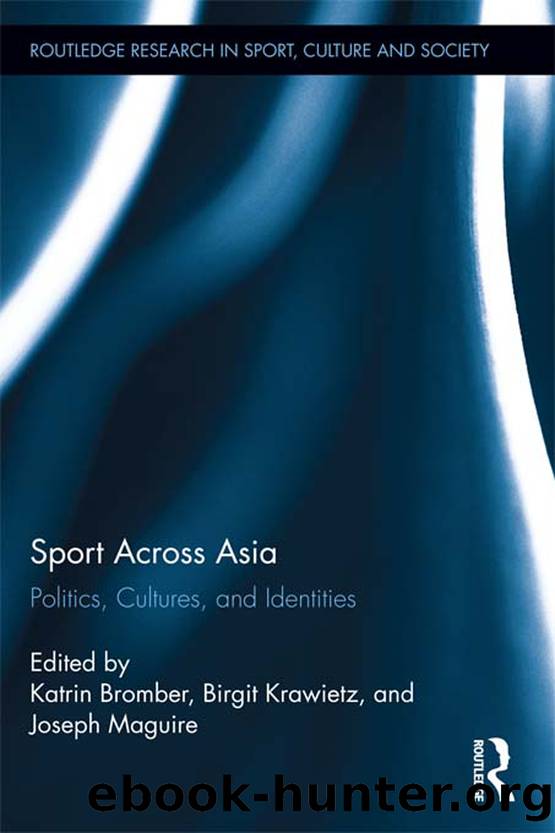Sport Across Asia by Bromber Katrin;Krawietz Birgit;Maguire Joseph;

Author:Bromber, Katrin;Krawietz, Birgit;Maguire, Joseph;
Language: eng
Format: epub
Publisher: Taylor & Francis Group
6 The Debate on âRevivalâ and the Physical Culture Movement in Western India (1900â1950)
Namrata R. Ganneri
INTRODUCTION: THE MARATHI LANGUAGE MONTHLY
The history of sports and athletics in the sub continent has increasingly come under the focus of academic research. Many acclaimed works faithfully plot the story of cricket as the ânational obsessionâ, so much so that a leading academic quips, âcricket is an Indian game accidentally invented by the Britishâ.1 As India's fortunes in the arena of modern sports come to be increasingly documented,2 a range of sub continental sporting activities, especially those characterized as âindigenousâ or âtraditionalâ, still await academic investigation.3 The north Indian tradition of wrestling, pahalwani and Kerala's martial art kalarippayyattu are however exceptions to this rule as seminal monographs by Joseph Alter on the former and Philip Zarrilli on the latter testify.4
Although western India5 is historically home to many a tradition of physical training, games, and martial bodily practices, it remains relatively under-researched.6 This chapter focuses on the âphysical cultureâ movement in western India at the turn of the 20th century.7 Further, even sensitive scholarship on western India perceives it as a âunitary movementâ either easily conflated with anti colonial nationalism or sliding into the right wing chauvinistic movements and organizations like the Rashtriya Swayamsevak Sangh.8 However, the nature of physical culture regimes institutionalized in this period defy such neat, mutually exclusive, binaries.
The movement was exemplified in the rapidly proliferating gymnasiums, locally referred to as akharas, vyayamshalas, and vyayammandirs, particularly in the second and third decades of the 20th century.9 This chapter, consequently, seeks to explain this surge of interest in physical training at the turn of the century. In both contemporaneous and a few academic accounts, however, this interest in physical training has been characterized as ârevivalâ or âreturn to indigenous sportâ.10 Building on Eisenstadt's insights about the multiple, and culturally determined, shapes of modernity,11 I seek to propose that the ârevivalâ was indeed a modern project of negotiating with ideas of health, strength, and physical fitness that were emanating from all over the world.
This movement, which seems to have begun at the turn of the 20th century, continued well into the 1930s when a distinct strand favoring military type drills and training with fire arms emerged. Most importantly, it sought to proselytize sports among the educated middle classes, and disciplined and regulated some âindigenous sportsâ.12 The leading ideologues, remarkably, utilized the vernacular public sphere and the available tracts and journals are a testimony to the dynamic debates about physical culture in this period. Primarily an urban trend, the movement, as I will show, was promoted by middle class, bilingual, more often than not upper-caste men (and some women).
The early 20th century marked the beginnings of overarching governmental concern with the institutionalization of physical education in primary and secondary schools. Significantly, the new physical culture clubs provided trained instructors, personnel, and pedagogic manuals that were utilized in the designing of the curriculum of physical education. This inquiry thus follows several paths: ideas about health and strength
Download
This site does not store any files on its server. We only index and link to content provided by other sites. Please contact the content providers to delete copyright contents if any and email us, we'll remove relevant links or contents immediately.
| Africa | Americas |
| Arctic & Antarctica | Asia |
| Australia & Oceania | Europe |
| Middle East | Russia |
| United States | World |
| Ancient Civilizations | Military |
| Historical Study & Educational Resources |
The Rape of Nanking by Iris Chang(3526)
The Sympathizer by Viet Thanh Nguyen(3510)
World without end by Ken Follett(3010)
Ants Among Elephants by Sujatha Gidla(2928)
Blood and Sand by Alex Von Tunzelmann(2611)
Japanese Design by Patricia J. Graham(2562)
City of Djinns: a year in Delhi by William Dalrymple(2139)
Inglorious Empire by Shashi Tharoor(2103)
In Order to Live: A North Korean Girl's Journey to Freedom by Yeonmi Park(2062)
Foreign Devils on the Silk Road: The Search for the Lost Treasures of Central Asia by Peter Hopkirk(2059)
Tokyo by Rob Goss(2022)
India's biggest cover-up by Dhar Anuj(1989)
India's Ancient Past by R.S. Sharma(1988)
The Great Game: On Secret Service in High Asia by Peter Hopkirk(1962)
Tokyo Geek's Guide: Manga, Anime, Gaming, Cosplay, Toys, Idols & More - The Ultimate Guide to Japan's Otaku Culture by Simone Gianni(1949)
Goodbye Madame Butterfly(1938)
The Queen of Nothing by Holly Black(1760)
Living Silence in Burma by Christina Fink(1734)
Batik by Rudolf Smend(1724)
